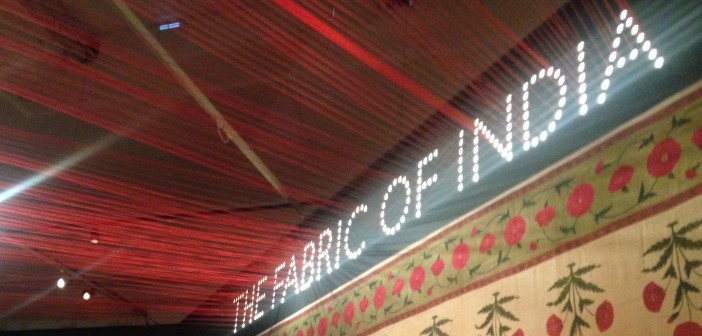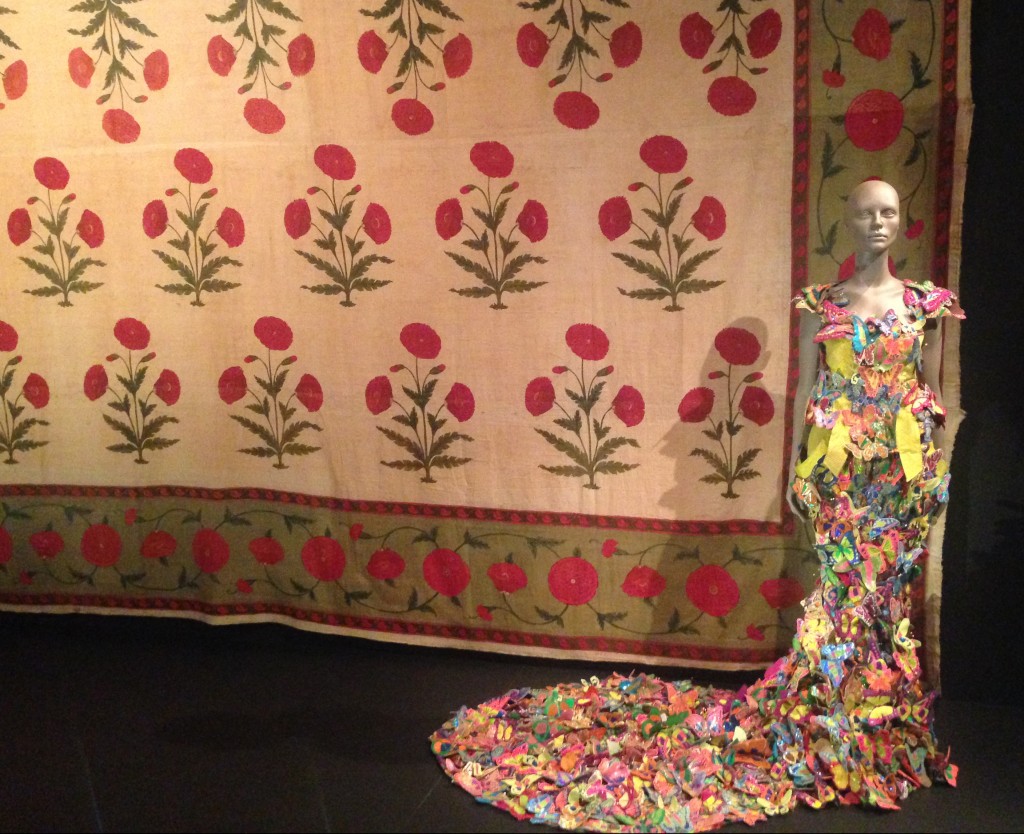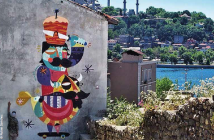At the Victoria and Albert Museum in London, the rich tapestry of India’s history is laid bare in a way most magnificent. Designed by Gitta Geschwendtner, The Fabric of India is a flagship exhibition of the V&A India Festival, and displays the finest handmade Indian textiles through the ages. Entering the exhibition, one is confronted with a breathtaking Mughal floor piece, flanked defiantly, in dramatic anachronism, by two unashamedly modern fashion pieces. One, a culturally-transcendent sari inspired by Western officewear, the other, a dazzling dress adorned with intricate butterflies made of the finest fabric. The sari and shirt ensemble is the brainchild of Abraham & Thakore, an Indian-based label. It was made by village craftsmen in Puttapaka, with the fabric expertly woven in the workshop of Shri Govardhana. The butterfly dress, upon which is adorned an astonishing array of fabric butterflies in blinding technicolour, was created by Manish Arora, a New Delhi-based fashion designer. The positioning of these pieces at the entrance was deliberate, to provide an impression of the nature of the exhibition, and the way the one constant of incredible fabric has drawn a thread through the ages.
The Fabric of India shows the incredible diversity of Indian textiles through the ages. Comprised of 200 objects, drawn from museums and private collections around the world, The Fabric of India is a model of artistic collaboration. The exhibition is divided into six aspects, each showcasing a unique facet of the use of Indian textile art. Underpinning the pieces, is of course a process, and the exhibit delves into the world of Indian textile manufacturing. The opening section of the exhibition displayed fabrics dyed with pomegranate and indigo, and showcases the series of complex techniques such as weaving, block printing, and embroidery. A stand-out of this section was a muslin skirt, decorated with the shiny wing casing of the green beetle.
India’s spiritual history is second to none. A diverse array of religious practices have found a home in the Subcontinent, and various pieces of textile artwork have been dedicated to spirituality. Centre-stage, an Islamic talismanic shirt dating from the 16th century. Embroidered delicately, and adorned with the full text of the Quran in ink and gold paint, the shirt was designed to be worn in battle as an under-shirt, to protect the wearer. But not all of the artefacts in The Fabric of India are dedicated to the divine. Luxurious floor spreads and hangings, adorned with the image of flowering plants, showcase the opulence and splendour of the Mughal and Deccan courts.
The historical impact of India’s textiles must not be forgotten. Indian textiles have been used all over the world for centuries, and on display are the oldest known fragments, dating back to the third century. A wall hanging from Gujarat was discovered abandoned outside a warehouse in Brooklyn, New York in 1994. Painstakingly conserved, the wall hanging is over 17 metres in length, and indeed fills the entire room. For the first time since its acquisition by the V&A, the colourful art-scape of people and elephants is showcased for all to see.
The Fabric of India extensively covers the use of fabric through the ages, and its importance to Indian, and global, culture. From bandanas from Madras and Gujurat found in West Africa, to the bed-hangings made for Austrian royalty, the truly global role of India’s textile industry is exhibited. The political tension undermining the impact of European industrialisation is also explored. The industrial revolution allowed the imitation of Indian fabrics, even leading to Indian-style fabrics manufactured in England for sale in India.
The Swadeshi (‘Own Country’) Movement was a resistance force, determined to shield the centuries-old techniques of Indian craftsmanship from the forces of cheap mass production. In many ways, this is a fight that undoubtedly continues to the present day. To produce Khadi became a symbol of the Indian independence movement. The display of contemporary Khadi pieces at The Fabric of India shows that this symbolism still resonates.
The Fabric of India is a truly immersive experience. A specially-made soundscape by Jason Singh allows the sounds of ancient India to flow through the exhibit, the fabric and music creating an almost dream-like vision of authentic India, drifting from centuries past.
The Fabric of India opens to the public on the 3rd of October, and runs until the 10th of January 2016. Tickets cost £14. Tickets can be booked in advance here.







